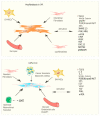Molecular Mechanisms and Cellular Contribution from Lung Fibrosis to Lung Cancer Development
- PMID: 34830058
- PMCID: PMC8624248
- DOI: 10.3390/ijms222212179
Molecular Mechanisms and Cellular Contribution from Lung Fibrosis to Lung Cancer Development
Abstract
Idiopathic pulmonary fibrosis (IPF) is a chronic, progressive, fibrosing interstitial lung disease (ILD) of unknown aetiology, with a median survival of 2-4 years from the time of diagnosis. Although IPF has unknown aetiology by definition, there have been identified several risks factors increasing the probability of the onset and progression of the disease in IPF patients such as cigarette smoking and environmental risk factors associated with domestic and occupational exposure. Among them, cigarette smoking together with concomitant emphysema might predispose IPF patients to lung cancer (LC), mostly to non-small cell lung cancer (NSCLC), increasing the risk of lung cancer development. To this purpose, IPF and LC share several cellular and molecular processes driving the progression of both pathologies such as fibroblast transition proliferation and activation, endoplasmic reticulum stress, oxidative stress, and many genetic and epigenetic markers that predispose IPF patients to LC development. Nintedanib, a tyrosine-kinase inhibitor, was firstly developed as an anticancer drug and then recognized as an anti-fibrotic agent based on the common target molecular pathway. In this review our aim is to describe the updated studies on common cellular and molecular mechanisms between IPF and lung cancer, knowledge of which might help to find novel therapeutic targets for this disease combination.
Keywords: cancer associated fibroblasts (CAFs); idiopathic pulmonary fibrosis; lung cancer; mechanotrasduction; myofibroblast.
Conflict of interest statement
The authors declare no conflict of interest.
Figures
References
-
- Raghu G., Remy-Jardin M., Myers J.L., Richeldi L., Ryerson C.J., Lederer D.J., Behr J., Cottin V., Danoff S.K., Morell F., et al. Diagnosis of idiopathic pulmonary fibrosis An Official ATS/ERS/JRS/ALAT Clinical practice guideline. Am. J. Respir. Crit. Care Med. 2018;198:e44–e68. doi: 10.1164/rccm.201807-1255ST. - DOI - PubMed
-
- Samarelli A.V., Tonelli R., Marchioni A., Bruzzi G., Gozzi F., Andrisani D., Castaniere I., Manicardi L., Moretti A., Tabbì L., et al. Fibrotic idiopathic interstitial lung disease: The molecular and cellular key players. Int. J. Mol. Sci. 2021;22:8952. doi: 10.3390/ijms22168952. - DOI - PMC - PubMed
-
- Raghu G., Collard H.R., Egan J.J., Martinez F.J., Behr J., Brown K.K., Colby T.V., Cordier J.F., Flaherty K.R., Lasky J.A., et al. An Official ATS/ERS/JRS/ALAT Statement: Idiopathic pulmonary fibrosis: Evidence-based guidelines for diagnosis and management. Am. J. Respir. Crit. Care Med. 2011;183:788–824. doi: 10.1164/rccm.2009-040GL. - DOI - PMC - PubMed
Publication types
MeSH terms
Substances
LinkOut - more resources
Full Text Sources
Other Literature Sources
Medical



